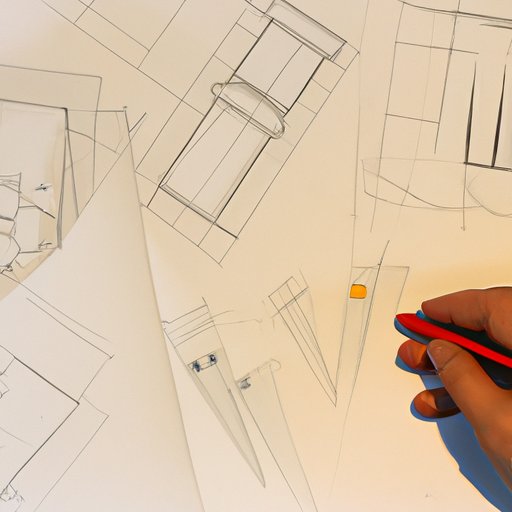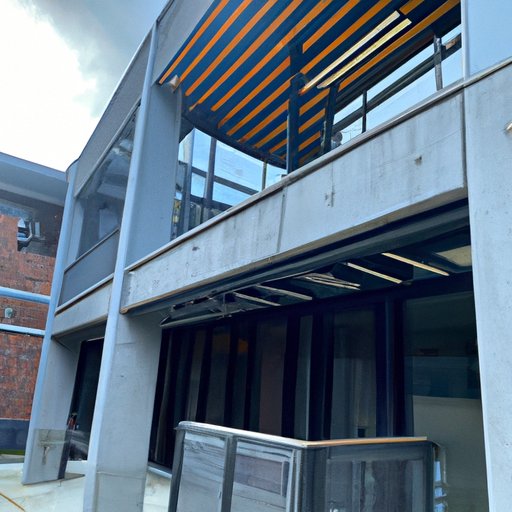Introduction
Architecture is the art and science of designing and constructing buildings and other physical structures. Architects play a vital role in the creation of the built environment, using their skills to design functional, safe, and aesthetically pleasing spaces that meet the needs of their clients. This article will explore what an architect does—from understanding the design brief and developing conceptual designs to working with other professionals and adhering to building codes and regulations.

Exploring the Design Process of an Architect
The design process begins when an architect meets with a potential client to discuss their project. During this initial meeting, the architect will listen to the client’s ideas and objectives and ask questions to gain a better understanding of the project. The architect will then use this information to develop a design brief, which outlines the parameters of the project and serves as a roadmap for the design process.
Once the design brief is established, the architect can begin to develop a conceptual design. During this stage, the architect will consider the spatial requirements of the project, as well as the aesthetic preferences of the client. The architect will also take into account any relevant building codes and regulations. The resulting design should be a balance of form and function that meets all of the client’s needs.
After the conceptual design has been approved by the client, the architect will create detailed drawings that specify materials, dimensions, and construction methods. These drawings are used by contractors and other professionals to construct the project. Throughout this phase, the architect will work closely with engineers, surveyors, and other professionals to ensure that the project is completed according to plan.

The Impact of Architecture on Society
Architecture plays an important role in shaping the built environment. Well-designed buildings can enhance the visual appeal of a city or town, making it a more desirable place to live and work. Good design can also have a positive effect on people’s health and wellbeing, providing them with comfortable and inviting spaces in which to relax and socialize.
In addition to aesthetics, architects also strive to promote sustainability in their designs. By incorporating green building techniques and materials, architects can help reduce the environmental impact of construction projects. For example, they may use renewable energy sources, such as solar panels or wind turbines, or incorporate recycled materials into the design. By doing so, they can help create a healthier and more sustainable built environment.
The Benefits of Hiring an Architect
Hiring an architect can be beneficial for both residential and commercial projects. An experienced architect will be able to offer professional advice and guidance throughout the design process, helping the client to identify their needs and develop a design that meets those needs. Architects also bring creative solutions to problems, such as finding ways to maximize space or minimize costs.
By working with an architect, clients can also benefit from cost-efficient designs. An architect will be able to provide budget estimates for the project, helping the client to stay within their budget and avoid costly mistakes. In addition, an architect can help to ensure that all necessary permits and approvals are obtained in a timely manner, reducing delays and ensuring that the project stays on track.

The Challenges of Being an Architect
Although there are many benefits to being an architect, it is not without its challenges. One of the most difficult aspects of the job is meeting the client’s expectations. An architect must be able to interpret a client’s vision and translate it into a design that meets their needs. In addition, the architect must be able to develop creative solutions to any problems that arise during the course of the project.
Adhering to building codes and regulations is also a challenge for architects. They must ensure that all of their designs comply with local and state laws, as well as any relevant industry standards. Finally, architects must stay up-to-date on the latest technologies and materials, as these can often provide innovative solutions to design challenges.
Examining the Education and Training of an Architect
In order to become an architect, individuals must complete a degree program at an accredited school of architecture. Most programs offer a Bachelor of Architecture (B.Arch.) degree, but some schools offer Master of Architecture (M.Arch.) degrees as well. During their studies, students will learn about design theory, construction methods, and building materials, as well as other topics related to architecture.
In addition to formal education, aspiring architects must also gain practical experience in the field. This is usually done through internships and apprenticeships, which allow students to apply the knowledge they have gained in the classroom to real-world projects. Once they have completed their education and training, architects must obtain a professional license in order to practice architecture.
A Look at the Future of Architecture
As technology continues to evolve, so too does architecture. New technologies, such as virtual reality, can be used to create immersive experiences that allow clients to visualize their projects before they are built. Innovative materials, such as self-healing concrete, can be used to create durable and sustainable structures. And architects are increasingly embracing sustainable practices, such as using renewable energy sources and incorporating green building techniques into their designs.
Conclusion
Architects play an important role in shaping the built environment. They are responsible for creating functional, safe, and aesthetically pleasing spaces that meet the needs of their clients. To do so, they must be knowledgeable about the design process, understand the impact of architecture on society, and keep up with the latest technologies and materials. With the right education and training, architects can help create a better and more sustainable built environment.
(Note: Is this article not meeting your expectations? Do you have knowledge or insights to share? Unlock new opportunities and expand your reach by joining our authors team. Click Registration to join us and share your expertise with our readers.)
